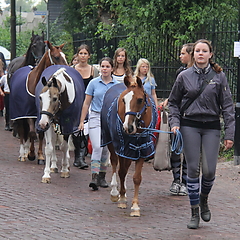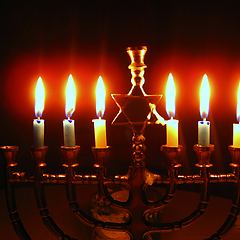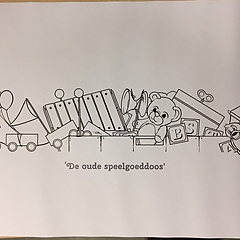Pride Amsterdam is a festival to celebrate that you can 'be who you are, love who you want'. This festival is mainly celebrated by the LHBTQI community from the last Saturday in July until the first Sunday in August and consists of several components. The most famous part is the Canal Parade, in which a procession of 80 boats cruise through the waters of Amsterdam for 2 hours, which is visited by hundreds of thousands of colourfully dressed visitors. Other parts of the Pride are: Pride Walk, Pride Park, Open Air Cinema, Senior Pride Concert, All Colours East, Love Swim, street parties and a closing party. The late mayor Eberhard van der Laan said about the Pride: ‘Pride Amsterdam is not just any event. It is a symbol of the open and tolerant city we want to be. We celebrate the freedom to be yourself. For twenty years, the boat parade has been inextricably linked to Amsterdam and an indispensable element of our city centre.’
Description
Community
The main organisation of the Pride is the Amsterdam Gay Pride Foundation. The foundation is a non-profit organisation that strives for emancipation, social and legal equality and acceptance of gays, bisexuals and lesbians and also for those who do not want to or cannot conform to socially dominant gender roles (such as male women, female men and queers) or whose gender of birth does not match the way one feels (such as transgenders).
The foundation is an umbrella organisation for the festival and cooperates for the different components of the festival with all LHBTQI organisations and companies that contribute to the realisation of the festival and with the committees: Boat Parade, PrideWalk, Art & Culture, Pride & Sports, Women & Pride, Youth & Pride, SeniorPride, TransPride and Corporates & Pride. The committees are committed to offering activities tailored to their target group and ensure greater visibility for that target group. The committees consist of representatives of civil society organisations and other parties involved.
Because the Pride consists of different elements, many different parties are involved in the Pride. In total there are about 220 organisations and 1100 people involved in the realisation of the festival, of which the people who work on the different components are divided as follows: Pride Walk = 5,000, Boat Parade = 10,000, parties = 75,000, programme content = 20,000. Hundreds of thousands of visitors come to the Pride every year, the best visited part of which is the Canal Pride.
History
In 1970, one year after the Stonewall riots, the world's first Gay Pride Parade was held in New York. After seven years, the first large demonstration, organised by the International Lesbian Alliance, took place in the Netherlands. This became an annual event called Pink Saturday since 1979, which takes place in a different city every year. Unlike Pink Saturday, Amsterdam Pride, as the event was called from 1996 to 2006, was not created as a demonstration or protest march. Amsterdam Pride was a party, organised by gay and lesbian entrepreneurs united in GBA (Gay Business Amsterdam), to promote Amsterdam as a gay nightlife city and to celebrate the freedom and diversity of the city. This is still anchored in the DNA of the festival.
Years later, emancipatory content was added to the Pride and the festival has grown from a one-day event to a nine-day internationally renowned LHBTQI festival that expresses the diversity of the LHBTQI community through sports, art and culture, pink church services, manifestations in various parts of Amsterdam and Lesbian, Senior and TransPride. After the 16th edition, in 2011, the Pride joined the international pride movement. Because of these developments, the Pride received the Bob Angelo Medal from the COC (Association for LHBTQI’s) in 2014. In recent years, gay activism has focused mainly on employers and sports associations and less on politics. This is often done from the inside and the result of this can be seen sailing along in recent years in the boat parade: the pink workers' associations of multinationals, which thus contribute to the ‘social norm’ of acceptance.
Safeguarding
In order to safeguard Pride Amsterdam for the future, the following actions will be taken:
2023-2025
- The organization continues to respond to current events and adapts to opportunities as they arise. For instance, in 2023, it focuses on the fact that Pride is there for everyone and that pride wants to be inclusive and about you.
- Amsterdam Gay Pride will continue with the Junior Pride alliance and look for funding to further build and roll out Junior Pride.
- Annually, all relevant documents will be archived at ILHIA. The dedicated WorldPride website will be archived by the Royal Library.
- Amsterdam Gay Pride invests a lot of time in its partners and promotes and encourages partnerships.
- Ways will be explored in which Pride Amsterdam can structurally make space for the wishes of groups who have not felt represented yet. Simultaneously, Amsterdam Gay Pride remains open to new groups and initiatives and points them to the funds it offers to support visibility and empowerment activities.
- Amsterdam Gay Pride sees it as its task to provide society with honest and transparent information. One is therefore going to launch a national campaign with objective information about the new transgender law.
- The possibilities will be explored to develop educational programmes and to bring young people together in a core or board group.
- In cooperation with various committees, ambassadors, partners and external parties, efforts will be made to create a diverse and innovative offer in which inclusion and diversity are central.
- The visibility of the Pride will be worked on by means of various actions, in which the entire programme, the message and the goal of the Pride are central.
- The Pride is well documented and archived. Possibilities to show this archive to a wider audience will also be explored.
- The Amsterdam Gay Pride is continuously working on collaborations; because the Pride is so large, there are many parties involved. The AGP also has contact with smaller Prides.
Contact
Stichting Amsterdam Gay PrideKorte Leidsedwarsstraat 12
1017RC
Amsterdam
Noord Holland
Netherlands
Website



